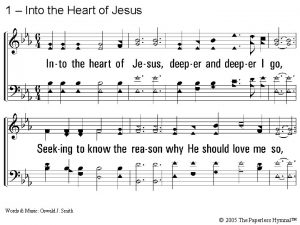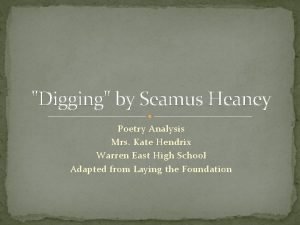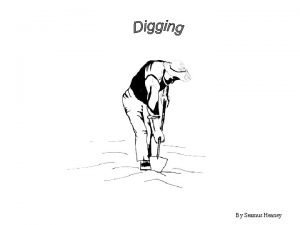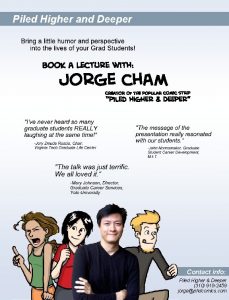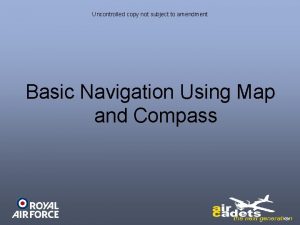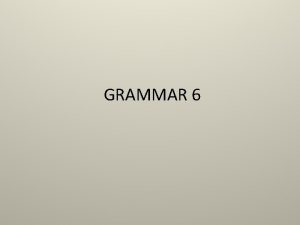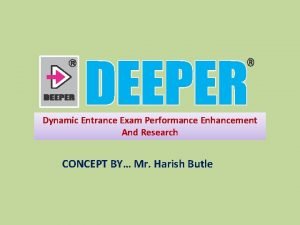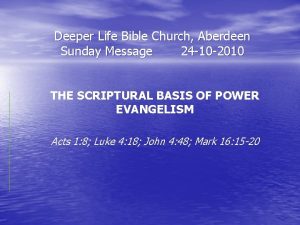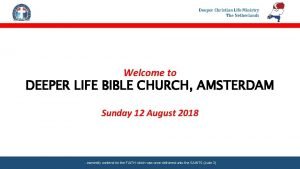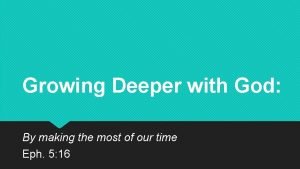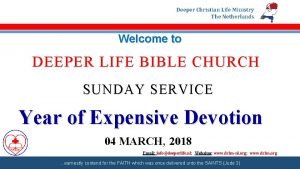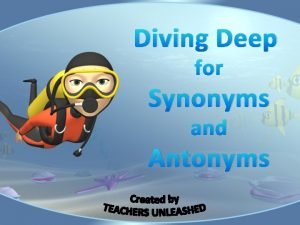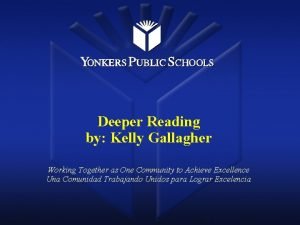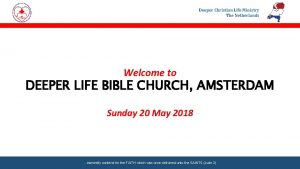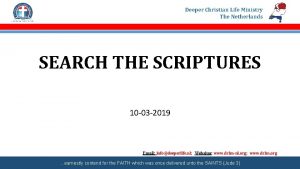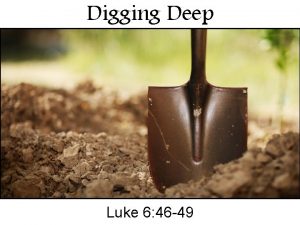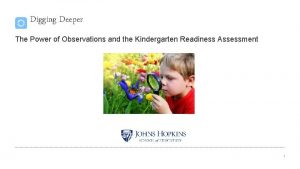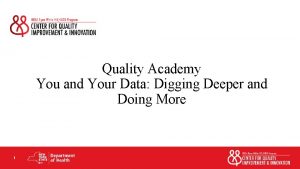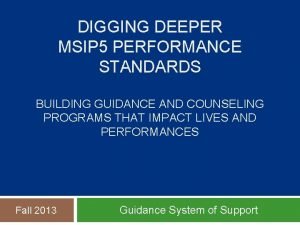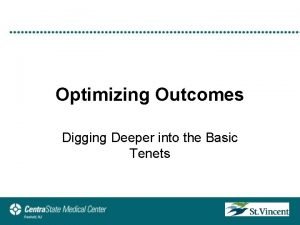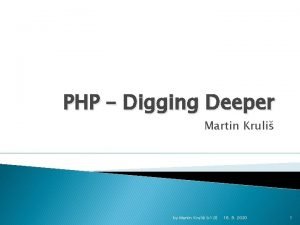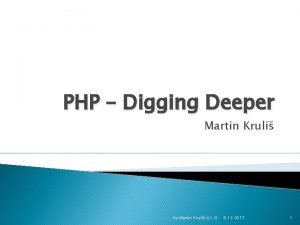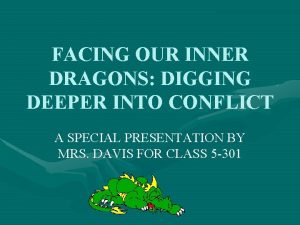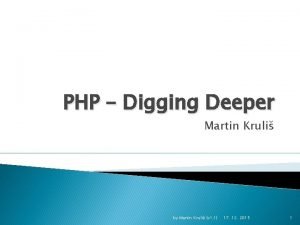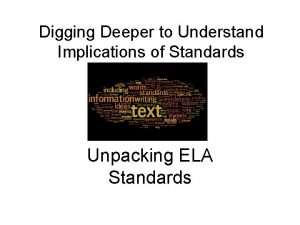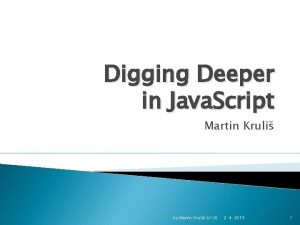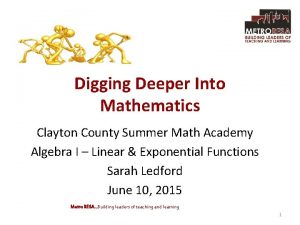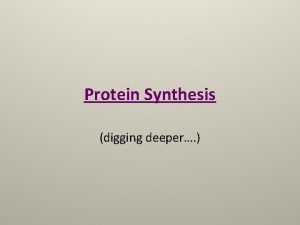Digging Deeper with Steps 1 and 2 North


































- Slides: 34

Digging Deeper with Steps 1 and 2 North Marion School District: Facilitator Mini Session September 2016 Signal Word: Step 1 + A Solid Foundation

Achievement of Results The L 2 Matrix & Data Teams Lucky Leading Losing Ground Learning Understanding Antecedents of Excellence

Objectives for the Day ▪ Dig deeper with Step 1 (Plan and Prepare) and Step 2 (Organize and Chart) of the data team process ▪ Reflect on current practices and next steps in your building/s

Proposed Norms 1. Pull your own learning wagon 2. Be mindful about time 3. Listen for catch and release signals 4. Technology has become one of our best assets & liabilities. . . Please set aside until prompted

Brainstorm: What do you do now when you have data (cause or effect)?

Step 1: Plan & Prepare Instruction What’s the order of this step? In your group, look at your card and find your place in the flow. Stand in order facing away from the other group when you are done!

The Flow of Step 1: Plan & Prepare ❏ Choose Priority standards ❏ Deconstruct to student friendly learning targets ❏ Select/revise a post assessment ❏ Use resources & materials to decide which lessons match, what to skip/skim, what needs to be supplemented ❏ Select additional strategies for Core ❏ Create pre-assessment ❏ Create scoring agreements

Preview of Steps to Deconstructing Standards: First: Write down the FULL Standard. Second: What is the Type of Target? Third: What are the Nouns? Fourth: What are the Verbs? Fifth: What are the Knowledge Targets that underpin the reasoning? Sixth: What are the Reasoning Targets? Last: Write targets in student friendly language.

Types of Learning Targets: Record Key Words & Sketch to Remember

Five Types of Learning Targets ▪ Knowledge Targets Factual information, procedural knowledge, and conceptual understandings underpinning each discipline. ● Reasoning Targets Thought processes students are to learn to do well within a range of subjects. ● Skill Targets Demonstration or physical skill-based performance is at the heart of the learning. ● Product Targets Where creation of a product is the focus of the learning. Specifications for quality of the product itself are the focus of teaching and assessment. ● Disposition Targets Attitudes, motivations, and interests that affect students’ approach to learning.

Let’s Practice: Name that Target Type! ▪ I can identify reasons an author gives to support the main point. Reasonin g ▪ I can apply fix-up strategies in my reading. Skill ▪ I can agree with an opinion verbally or in writing. Reasonin ▪ I can recognize root words in text. Knowledgeg ▪ I can create a visual aide to support my argument. Product ▪ I can persevere through challenging tasks. Dispositio n

What Does it Look Like to Deconstruct a Standard? ▪ First, write down the FULL Standard: ▪ ▪ Second: What is the Type of Target? ▪ ▪ Reasoning Target Third: What are the Nouns? ▪ ▪ 2. NBT. 9: Explain why addition and subtraction strategies work, using place value and the properties of operations. Addition, subtraction, place value, properties of operations Fourth: What are the Verbs? ▪ Explain (using place value and properties)

Fifth: What are the Knowledge Targets that underpin the reasoning? ● Know addition and subtraction strategies using place value and properties of operations related to addition and subtraction. Sixth: What are the Reasoning Targets? ● Explain why addition and subtraction strategies work based on place value and properties of operations.

Last: Write targets in student friendly language. ● I can name addition strategies. (pre-req) ● I can name subtraction strategies. (pre-req) ● I can explain why addition strategies work using place value and properties of operations. ● I can explain why subtraction strategies work using place value and properties of operations. ● I can use drawings or objects to support my explanations.

As you Deconstruct Standards, Remember If… Then… ● ● If a standard is knowledge… If a standard is reasoning then… If a standard is a skill then… If a standard is a product then… K= K targets R= K+R targets S= K+R+S Targets Note: Disposition can both stand alone or be paired with any other target type. P= K + R +S*+P targets (*Not always S)

Assessment Methods ▪ Selected Response ▪ ▪ Students select the correct or best response from a list provided. Written Response ▪ Students construct an answer in response to a question or task rather than to select the answer from a list. ● Performance Assessment Reflection: ○ Students complete Where did a task that is the majority evaluated by of your judging the level brainstorme of quality using a d methods rubric. fall? ● Personal Communication ○ Students share what they have learned through structured and unstructured interactions with teachers.

Target-Method Match Selected Response Written Response Performance Assessment Personal Communication Knowledge Reasoning Skill Product Strong, Good, Partial or Poor Match?

Target-Method Match Selected Response Written Response Performance Assessment Personal Communication Knowledge Good Strong Partial Strong Reasoning Good Strong Partial Strong Skill Partial Poor Strong Partial Product Poor Strong Poor

The Team Process Sheet The process sheet is a place to capture the conversation 1. Have one person on your “team” enter this link: https: //goo. gl/UP 4 lxj 1. Click: make a copy 2. Next, share the “sheet” with your two teammates 3. Take a moment to click around and check it out 4. Set aside until prompted Remember this is not the outcome, it is a scaffold!

The Flow of Step 1: Plan & Prepare ❏ Choose Priority standards ❏ Deconstruct to student friendly learning targets ❏ Select/revise a post assessment ❏ Use resources & materials to decide which lessons match, what to skip/skim, what needs to be supplemented ❏ Select additional strategies for Core ❏ Create pre-assessment ❏ Create scoring agreements

Step 1: Plan & Prepare Instruction Considerations • Have teachers taken the CFA to check for clarity and to better infer when students will struggle? • Have clear criteria been identified (cut-off scores) for each group of students? Hint: 100% does not equal Exceeding • How will CFA results be shared with students? • How will students demonstrate their learning? Plan and prepare instruction

The Flow of Step 1: Plan & Prepare ❏ Choose Priority standards ❏ Deconstruct to student friendly learning targets ❏ Select/revise a post assessment ❏ Use resources & materials to decide which lessons match, what to skip/skim, what needs to be supplemented ❏ Select additional strategies for Core ❏ Create pre-assessment ❏ Create scoring agreements

Life is Busy & Agendas are Tight Don’t Forget That Step 1 is. . .

Roadmaps to Learning… Common Core State Standards Identify desired results. (Targets) Determine acceptable evidence. (Assessment) Plan learning experiences and instruction. (Strategies and Lessons)

Step 1: Guided Practice Tips of the Trade: ▪ If your district does not have a resource for prioritized standards, Northwest Regional ESD has done this work: http: //et. nwresd. org/node/281 ▪ Read the map from left to right and right to left. ▪ Make sure that all the parts link together. ▪ Follow the “FLOW” of Step 1.

Reflection: Where are we now? Use the Team Process Sheet and the Comprehensive Observation Rubric (COR) to reflect and set specific goals.

Step 2: Organize and Chart Data • Score the assessment based on the rubric • Chart data into categories: • Exceeding/Meeting POSSIBLE • Close to Proficient NAMES • Far To Go/Approaching • Intervention • Select a group of students to focus your plan on NOTE: Teachers need time to think and reflect as they chart data. Therefore, it is NOT recommended that this happen during the meeting. Organize and chart data

Scoring Agreements Review Work together to: ▪ Decide how to score the assessment to get the most actionable information ▪ Take the assessment to check for clarity and to better infer where students will struggle ▪ Identify clear criteria (cut-off scores) for each group of students that will best reveal their needs (What is meeting? close? etc. ) Remember: 100% does not automatically equal exceeding!

Pre-Assessment Column Cut Score Review Proficient/Exceeding: Student has mastered the standard (not time dependant) Remember Close to Proficient: the goal of the columns is Students who the prerequisite skills needed and to have reveal student need. some portions of the current standard. Far To Go/Approaching: Try to avoid making column Students who have some prerequisite skills. May or may not havedescriptors correct responsesthat on the of focus. a current widestandard variety of Intervention: students will fall into. Students who lack most or all of the prerequisite skills.

Step 2: Guided Practice! Tips of the Trade: ▪ Make sure your cut scores allow for students to be separated out into groups with like needs. If most of your students will end up in one group, change your cut scores BEFORE you chart. ▪ Sometimes it may be easier to use descriptors for cut scores, rather than numbers.

Reflection: Where are we now? Use the Team Process Sheet and the Comprehensive Observation Rubric (COR) to reflect and set specific goals.

Dear Facilitator … Burning questions? Concerns? Confusion? What are you still wondering about?

www. educationalexcellence. org

Feedback and Reflection 1. Please complete a reflection and feedback form before you leave (last page). 1. Bus your own table.
 Vietnam war at home webquest answers
Vietnam war at home webquest answers Into the heart of jesus deeper and deeper i go
Into the heart of jesus deeper and deeper i go Ics north east
Ics north east Chapter 14 north and south
Chapter 14 north and south Digging poem summary
Digging poem summary Squat pen
Squat pen How to dig in volleyball
How to dig in volleyball Deeperph
Deeperph True north vs magnetic north
True north vs magnetic north The north pole ____ a latitude of 90 degrees north
The north pole ____ a latitude of 90 degrees north Axial and locomotor movements examples
Axial and locomotor movements examples Go deeper in christ
Go deeper in christ Deeper life bible church netherlands
Deeper life bible church netherlands Deeper life netherlands
Deeper life netherlands Deeper life bible church netherlands
Deeper life bible church netherlands Deeper life bible church netherlands search the scriptures
Deeper life bible church netherlands search the scriptures Deeper
Deeper Deeper life messages
Deeper life messages Dclm netherlands
Dclm netherlands Deeper learning conference
Deeper learning conference Deeper life bible church
Deeper life bible church Deeper life youth search the scripture
Deeper life youth search the scripture Growing deeper in god
Growing deeper in god Deeper life netherlands
Deeper life netherlands Deeper life netherlands
Deeper life netherlands Dclm netherlands
Dclm netherlands The deeper christian life
The deeper christian life Deeper life netherlands
Deeper life netherlands Deeper life canada
Deeper life canada Your love is deeper than the ocean higher than the heavens
Your love is deeper than the ocean higher than the heavens Dive deep synonyms
Dive deep synonyms Kelly gallagher deeper reading
Kelly gallagher deeper reading Deeper life netherlands
Deeper life netherlands Deeper life netherlands
Deeper life netherlands Deeper life netherlands
Deeper life netherlands

